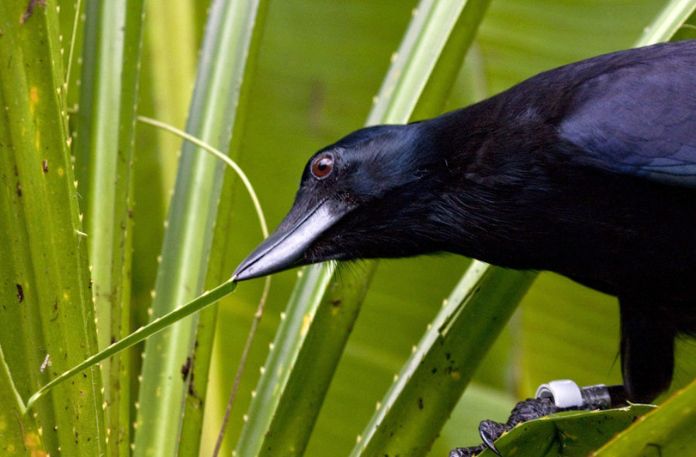Today’s Bird of the Day, the Australian raven (Corvus coronoides), is the closest native bird we have in urban Sydney to Robyn Williams’ favourite bird, the New Caledonian crow (Corvus moneduloides).
Williams is a legend of science broadcasting, having hosted The Science Show on ABC Radio National since 1975 – at one time the channel’s most popular show and one of the longest-running radio shows in the world.
He has conducted many interviews and broadcast stories about birds and biodiversity.
Crows (and ravens) have a great reputation for being intelligent and a Williams’ story from 2002 was about Betty the New Caledonian crow, after which he named one of his books, In Love with Betty the Crow.
The New Caledonian crow is known for its use of tools. Williams’ story was about behavioural ecologist Alex Kacelnik, who conducted experiments with crows trying to retrieve food from tubes using pieces of wire. The crows had to use hooks the right length to obtain the food.
When a male crow crowded out Betty, took the food and left with the hooked tool, Betty bent a piece of wire into the correct length to hook out some food for herself.
A student filming the crows had accidentally left the video running, recording Betty’s exploits, and providing a major story in the journal Science.
Williams later visited New Caledonia and learned how crows also made tools from the leaves of the screw pine (Pandanus) tree. He thinks crows are wonderful.
Now living in Gerroa, he has visits from 20 different species of birds. A particular favourite are king parrots, which he said had extraordinarily beautiful plumage, usually turned up in pairs and were very tame.
He fed them seeds from a silver tray “because they are royal” and to prevent other birds stealing their food.
Rewilding and biodiversity
Williams has a strong interest in the environment and biodiversity (the first episode of The Science Show, 47 years ago, covered the threat of climate change and recommended readers look for a recent Science Show program on rewilding the Scottish highlands and the novel Once There Were Wolves by Australian author Charlotte McConaghy (read the SSH review of the book here).
Williams also recalled another Science Show special on Miriam Rothschild.
Rothschild, at the time of the interview in 1993, was an 85-year-old, self-taught natural scientist who had planted the wild flowers at (then) Prince Charles’ Highgrove estate in Gloucestershire.
Because she knew lots about butterflies she was consulted by Prince Charles to see how he could get them to gather at Highgrove.
In the 1980s both Prince Charles and Rothschild were ferocious campaigners for respecting the environment and using it sustainably.
They also wanted to reintroduce wildflowers to Britain. Since World War II a staggering 95 per cent of Britain’s herb-rich grasslands had been wiped out and with that came the obliteration of insects, animals and plants.
Prince Charles said, “I want to try and leave something better behind than I found. We need to make sure that we look after the countryside and our environment in a way that doesn’t prejudice our grandchildren’s chances. This is really what lies behind what is now described as sustainable development.”
The Science Show airs on Saturdays at 12pm and is repeated on Mondays at 4am, and Wednesdays at 12pm.
_______________
Follow @southsydneyherald on Instagram to see our birds of the day and learn about protecting urban biodiversity.






